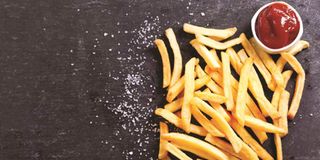Child nutrition: Winning the war against junk food addiction

On things that influence children’s nutrition, there is a lot of exposure today, not just on TV but with gadgets as well.
What you need to know:
- On things that influence children’s nutrition, there is a lot of exposure today, not just on TV but with gadgets as well.
- Junk food companies invest in food scientists and top chefs who create the most tasteful foods such that you want to go back for more.
Children today are exposed to hundreds of food commercials on TV, on Billboards and Online.
At the supermarket, there are shelves upon shelves of candies and snacks.
Even the neighbourhood shopkeeper keeps a good stock of, crisps, colourful waffles, sweets and biscuits.
As a parent, how do you overcome the palpable pressure to grab a snack for your little ones?
In the wake of scandals involving children’s candy companies such as the recent ban on Kinder Joy in the US, most parents can’t help but worry if they are one sweet away from a doctor’s visit.
Are all snacks a health hazard to your children?
We hear from two mums and a nutritionist on how to maintain a healthy, wholesome diet for your children and the place of snacks in such a diet.

Anna Wanjiru, Founder of My Planted Kitchen and Certified Culinary Nutrition Expert, Health Coach.
Anna Wanjiru, My Planted Kitchen
When Anna Wanjiru, a mum of three and a Certified Culinary Nutrition Expert and Health Coach hit 108 kilos in 2016, it was a turning point.
She had just had her second child and weighing over 100kgs began taking its toll on her mental and physical health.
She was tired and depressed all the time, until she decided to make some changes.
“My motivation was my kids because I wanted to keep up with them and be around for longer- sometimes weight comes with health complications.”
In just a year, she had hit her goal of shedding 30kgs. But along the journey, she encountered challenges in keeping up with a healthy lifestyle.
“I started feeling fatigued and my mind was foggy. When losing weight, you may under eat or overeat one type of food if you are not well informed. I took a culinary nutrition programme by the Academy of Culinary Nutrition in Canada, to learn more about nutrition,” she says.
Her weight loss journey was an eye-opener to how we can use food to heal and build our bodies or alternatively feed diseases. She shares her two cents on the topic of children and nutrition:
When it comes to my children, I didn’t want to overwhelm them with my diet.

Wangeci Wandere Kihara (Mama Muthoni) is a Certified Lactation Specialist, Child Nutrition Practioner and Founder of The Mothership.
Initially, we would have two sets of meals- my diet and the family diet.
After a while I started making small changes for them- say, from white rice or white ugali to brown. Sometimes I would give them an option to choose.
Luckily it worked, though to this day there are things they refuse to take like smoothies. They prefer to eat the fruits whole and we compromise in such scenarios.
On things that influence children’s nutrition, there is a lot of exposure today, not just on TV but with gadgets as well.
When a child is on YouTube, food commercials pop up and when one sees something over and over again, it’s imprinted on their mind.
The next time they walk into a supermarket, they will ask for what’s imprinted on their mind.
Advertisers use subliminal messages that are carefully crafted. These messages create the fear of missing out.
For instance, if they see cool people in an advert taking a certain snack, they imagine they are not having fun if they miss out on the same snack.
While snacks are not necessarily bad, there is a lot of information that junk food companies fail to disclose, particularly associated health risks.
Take the recent scandal involving Skittles, for instance. It emerged that some of the colours on the candy come from a food additive called Titanium Dioxide.

A close-up of chocolate, oatmeal cookies, drop candies and muesli bars on a plate.
The person who sued the company alleged that the additive is linked to cancer and is unfit for human consumption.
This is just one brand, but there is a wide range of foods and candies with additives whose side effects we may not be aware of. The unknown facts are what we should be worried about.
Parents today are competing with foods that are very sweet and some are designed to be addictive.
Junk food companies invest in food scientists and top chefs who create the most tasteful foods such that you want to go back for more.
It’s a losing battle from the beginning and if a parent is not creative with what they feed children from the onset, they may struggle to convince them that home-cooked meals are as fun and tasty as what they see in commercials or on supermarket shelves.
Parents are also delegating kitchen duties to their nannies, who make major food decisions for their children and sometimes the whole family.
Though there is nothing wrong with this, it’s difficult to track your child’s eating habits and correct negative attitudes early.
“We ran a program in 2021 where we would take nannies through training on how to prepare healthy foods. Most nannies are as informed as their background and their exposure. To some, quantity is what matters. They might end up overfeeding the children, and as a result, the child loses their fullness cue, thus predisposing them to obesity. Other house managers, do not know what to do with interesting ingredients like capsicum and red cabbage which are rich in micronutrients.”
“My idea of a healthy diet includes, whole, healthy ingredients and foods that look as they did when they were harvested. I try to buy and cook fresh ingredients while avoiding foods that come with labels and a long list of chemical ingredients as much as possible. I also value nutrition, rather than feeding children on dead calories.

A woman holding plates with fruits and desserts.
Like any other parent, I encounter resistance from my children sometimes, but getting them involved in the kitchen helps a lot.
Studies show that when kids are involved in food preparation, they are likely to eat that food because they are proud of their work.
When they refuse to take something, I try to understand where they are coming from.
Like the smoothie issue, I had to understand it’s the texture they didn’t like but they enjoyed the crunch of raw fruits.
Children are not that complicated- sometimes their resistance could just stem from how food is presented to them.
Some kids don’t like their foods mixed and mashed together. A segmented plate can solve picky eating just as easily.
I also try to be realistic and maintain balance. From Monday to Saturday our main snack is fruit though we complement with sandwiches and popcorn.
Sunday is our free day and I let the children choose what they want to eat, though I avoid using pizzas and the likes to reward or punish them.
The healthy meals I offer them are also fun-like banana bread so they don’t get bored.
My advice to parents who are struggling to get their children on a healthy diet- is you control the supply line, you are in charge and you have to own that responsibility.
Even though they pester you and throw tantrums, you are the adult.
Wangechi Kihara, Founder of the Mothership
Wangeci Kihara, a child nutrition practitioner and a lactation specialist started understanding nutrition from a different angle when she became a mother.
Her idea of motherhood was blissful as presented by mothers around the world. On the contrary, motherhood brought her a sense of aloneness.
There were so many other mothers around her but few were talking about the challenges that come with this beautiful journey.
She decided to start a platform to help other mothers figure out one of the hardest nuts to crack; proper nutrition. Here are her thoughts on the topic:
“As a parent, I learned earlier on, that children learn by observing the adults around them. They do not learn by listening. Hence the biggest challenge in training my children to eat right was maintaining a healthy diet myself.
You can’t tell them to eat vegetables if you are always eating junk food. This was tough because I’ve always had a sweet tooth, and so I had to be very strict on my diet, especially after my first child.
Indeed, commercials do affect children, but it does not end there. Cartoons and the shows they watch affect them a lot more.
Sometimes the impact is beyond children gravitating toward junk food and unhealthy eating patterns.

French fries with ketchup on a dark table.
Content shapes their body image and its relationship to food. Parents really need to be careful with what children consume and the people they allow in their lives.
If you raise your children around people who have body image issues and only keep a certain diet because they are fat, your child will grow up thinking body image issues are normal and that healthy eating is only necessary for supermodels.
But if you raise your children around people who eat healthily and are wholesome, then your children will adopt a positive attitude toward food.
Remember, you’re not the only authority around your child’s life. Children also pick ideas about food and life from other children and other homes.
If their friend says my mother made me very good broccoli, then your child will come home and ask for the same.
I like to look at food in a wholesome way. If a child has about 35 meals in a week (breakfast, lunch and supper), it does not matter whether they have fries only, in one meal, as long as they consume other nutritional foods from various food groups within those 35 meals.
We have to create a good relationship between what we think is unhealthy food and what we consider healthy.
For instance, if you tell your child that they have to finish eating their food first before you give them a sweet, then they develop the idea that sweets are forbidden and they have to look forward to them.
They are likely to overlook the importance of healthy meals or even hide and throw food to earn the sweets.

A burger and fries at Boho Restaurant.
Snacks should never be used as rewards. Eventually, when they leave the nest, the child may not know how to create a healthy balance between junk food and healthy meals.
One of the common mistakes parents make is the choice of weaning food when the child is between 0-18 months.
They only offer one variety of food like matoke or porridge. And when they eventually start feeding them more food with different textures and flavours, the children become picky.
As mentioned above, I believe in giving children wholesome diet-which means the child experiences all sorts of tastes and nutrients from different food groups.
When I’m preparing meals in my home, for instance, we will have three food groups such as protein starch and fat for breakfast.
I also allow my children to eat fun foods like pizzas and sausages and we bake cakes, mandazis and every nice thing we can have in our diet.
But I ensure healthy foods make up a big percentage of what we eat.
I’m also keen on cooking with organic ingredients. I try to avoid canned and processed foods as much as possible.
For instance, I’d rather have the real tomato fruit than tomato paste because we are blessed with organic ingredients in Kenyan markets.
Variety is important as well. For example, instead of feeding my children with one type of protein, I will incorporate different food groups and sources both plants and animals.
I’d say to parents- try as much as you can to ensure your children have a good relationship with food and this starts with your attitude.
Help them understand why they need variety on their plate. You do not have control over what they put on their plates for a long time.
Once they go to school, they have the freedom to choose what to eat or buy. If you just say no without an explanation, they will never understand and might choose to over-explore once they get the freedom.





